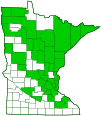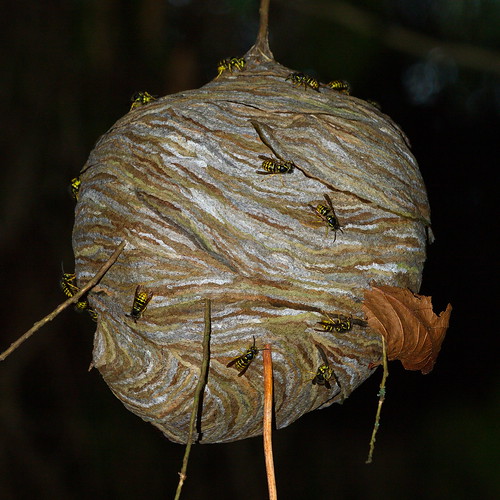common aerial yellowjacket
(Dolichovespula arenaria)
Conservation • Description • Habitat • Ecology • Distribution • Taxonomy
Conservation Status |
|
|||||||
| IUCN Red List | not listed |
|||||||
| NatureServe | NNR - Unranked |
|||||||
| Minnesota | not listed |
|||||||
Description |
||
Common aerial yellowjacket is a medium-sized, predatory, social wasp. It occurs throughout North America north of Mexico. It is one of the most common aerial yellowjackets in eastern North America. It is common in Minnesota. In natural areas, its nests are found in trees and shrubs. In urban and suburban areas, its nests are frequently found on buildings. Adults are ⅝″ to ¾″ long and are black with bright yellow markings. The body is stout and slightly wider than the head. The head and thorax are densely covered with long erect hairs. The abdomen is less hairy. There are two large compound eyes, one on each side of the head, and three small simple eyes (ocelli) at the top of the head between the compound eyes. The ocellar triangle is very close the the rear margin of the head. The gap is less than the length of the ocellar triangle. The gap between the jaw (mandible) and the compound eye is broad, about two times the diameter of one ocellus. The top of the head (vertex) between the compound eyes is entirely black—there is no yellow “eye loop”. There is a yellow band behind each compound eye. It is continuous to the mandible, not interrupted, but is usually narrowed or notched in the middle. The area below each compound eye (ocular sinus) is mostly yellow. The face is yellow with a single black spot in the middle. The spot is variable in size and shape. The upper lip (clypeus) is broadly cut off, more or less notched at the tip. The antennae are thread-like, black above, and yellow below. They have 12 segments on the female, 13 segments on the male. On the male, each segment near the tip has two long narrow glands in the underside. The front part of the body (mesosoma) includes the thorax and the first segment of the abdomen. The thorax is mostly black with yellow markings. The exoskeletal plates on the upper side of the thorax, from front to rear, are the pronotum, scutum, scutellum, and metanotum. The pronotum extends back to the small plate covering the base of each forewing (tegula). The hind angles are not lobed. There is an elevated ridge (carina) around the sides and front of the pronotum. It is yellow and is interrupted at the apex (nearest to the head). The tegulae are yellow. The scutum is usually entirely black. Occasionally there is a pair of short longitudinal lines near the rear margin. The lines, when present, are thin, poorly defined, and sometimes barely visible. The scutellum is rectangular and much wider than long. It has a pair of broad yellow spots on the front margin. The metanotum is narrow and has a pair of narrow spots. On each side of the thorax, the plate on the second segment (mesopleuron) has a large yellow spot at the top. The abdomen of the female has six segments, while that of the male has seven segments. The upper plate (tergum) of each abdominal segment is black and yellow, sometimes mostly black, sometimes mostly yellow. The front margin is black. The rear margin is yellow and is deeply notched in the middle. There is a pair of black spots on terga 2 through 6 (T2 through T6) on the female, T2 through T7 on the male. The black on the front margin often extends into the black spots. On T1 there is no pair of black spots. On T1 and T2 the yellow is very deeply notched and usually interrupted in the middle of the rear margin. On the male the tip of the abdomen is rounded. The wings are smoky and clear. The hindwing does not have a lobe (anal lobe) at the base. The legs are yellow. The fourth segment (tibia) of the middle leg has two spurs at the tip. The last part of each leg (tarsus), corresponding to the foot, has five segments. There is a claw at the end of the last segment. The claw tapers to a point. It is not divided at the tip. |
||
Size |
||
Total length: ⅝″ to ¾″ |
||
Similar Species |
||
Habitat |
||
|
||
Ecology |
||
Season |
||
Late May through October (CCESR) |
||
Behavior |
||
The forewings are folded when at rest. Workers of this species are able to spray venom in the presence of a threat. This is thought to release pheromones that attract other workers to attack the threat. |
||
Life Cycle |
||
In the spring a queen emerges from hibernation, mates, and chooses a nesting site. In early summer she builds a papery nest above ground into which she deposits eggs.When the eggs hatch she feeds the young and continues laying eggs. These young become workers and take over the care of new young and the expansion of the nest. Nest size peaks in mid-summer and dwindle in size through the late summer and fall. The nest is large and the cells are completely enclosed within the outer envelope. In Minnesota the nests do not survive the winter. Males die soon after mating. Old queens and workers are killed by cold weather in the fall, while new queens hibernate. |
||
Larva Food |
||
Pre-chewed fragments of caterpillars and other soft-bodied insects. |
||
Adult Food |
||
Live arthropods, including caterpillars and lady beetles; young hummingbirds; plant nectar; juices of ripe fruits. |
||
Distribution |
||||
|
Sources |
|||
| 8/27/2023 | ||||
Occurrence |
||||
Common in Minnesota |
||||
Taxonomy |
|||
Order |
Hymenoptera (ants, bees, wasps, and sawflies) | ||
Suborder |
Apocrita (narrow-waisted wasps, ants, and bees) | ||
Infraorder |
Aculeata (ants, bees, and stinging wasps) | ||
Superfamily |
Vespoidea (vespoid wasps) | ||
Family |
Vespidae (hornets, paper wasps, potter wasps, and allies) | ||
Subfamily |
Vespinae (hornets and yellowjackets) | ||
Genus |
Dolichovespula (aerial yellowjackets) | ||
Synonyms |
|||
Vespula arenaria |
|||
Common Names |
|||
aerial yellowjacket common aerial yellowjacket sandhills hornet |
|||
Glossary
Carina
An elevated keel or ridge.
Clypeus
On insects, a hardened plate on the face above the upper lip (labrum).
Mesosoma
In Hymenoptera: the front part of the body, consisting of all three segments of the thorax and the first segment of the abdomen, to which the wings are attached.
Ocellus
Simple eye; an eye with a single lens. Plural: ocelli.
Pronotum
The exoskeletal plate on the upper side of the first segment of the thorax of an insect.
Scutellum
The exoskeletal plate covering the rearward (posterior) part of the middle segment of the thorax in some insects. In Coleoptera, Hemiptera, and Homoptera, the dorsal, often triangular plate behind the pronotum and between the bases of the front wings. In Diptera, the exoskeletal plate between the abdomen and the thorax.
Scutum
The forward (anterior) portion of the middle segment of the thorax (mesonotum) in insects and some arachnids.
Tarsus
On insects, the last two to five subdivisions of the leg, attached to the tibia; the foot. On spiders, the last segment of the leg. Plural: tarsi.
Tegula
A small, hardened, plate, scale, or flap-like structure that overlaps the base of the forewing of insects in the orders Lepidoptera, Hymenoptera, Diptera, and Homoptera. Plural: tegulae.
Tergum
The upper (dorsal) surface of a body segment of an arthropod. Plural: terga.
Tibia
The fourth segment of an insect leg, after the femur and before the tarsus (foot). The fifth segment of a spider leg or palp. Plural: tibiae.
Vertex
The upper surface of an insect’s head.
Visitor Photos |
|||||
Share your photo of this insect. |
|||||
| This button not working for you? Simply email us at info@MinnesotaSeasons.com. Attach one or more photos and, if you like, a caption. |
|||||
Alfredo Colon |
|||||
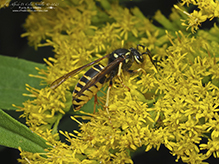 |
|||||
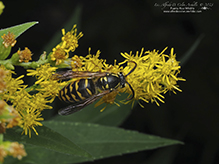 |
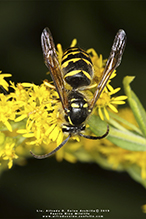 |
||||
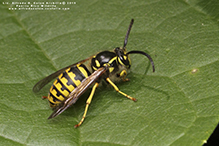 |
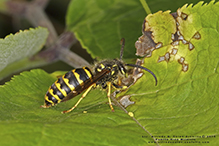 |
||||
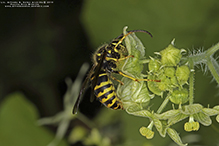 |
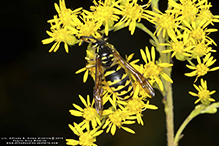 |
||||
MinnesotaSeasons.com Photos |
|||||
|
|||||

Visitor Videos |
|||
Share your video of this insect. |
|||
| This button not working for you? Simply email us at info@MinnesotaSeasons.com. Attach a video, a YouTube link, or a cloud storage link. |
|||
Other Videos |
|||
| Dolichovespula arenaria maculifrons |
|||
About
Published on Jun 19, 2012 |
|||
| Common Aerial Yellowjacket (Vespidae: Dolichovespula arenaria) on Blossom Carl Barrentine |
|||
About
Uploaded on Aug 8, 2010 Photographed at Itasca State Park, Minnesota (06 August 2010). |
|||
| Inside The Wasp's Nest Vol. 1 - Aerial Yellowjacket - RE-UPLOADED IN HIGH QUALITY Andy Wehrle |
|||
About
Uploaded on Feb 5, 2009 I am re-uploading this video so that the "Watch in High Quality" option will be available. This is a movie I made using footage of a tree nest a friend found across the street from his house in 2003, and the nest built under our deck out back in 2004. The aerial yellowjacket, species Dolichovespula arenaria, looks very similar to the pesky ground-nesting yellowjackets in the genus Vespula, and builds aboveground nests very similar to those of the larger baldfaced hornet, Dolichovespula maculata. The video ends with the complete footage from the short disturbed-nest clip I used to have up, "Yellowjacket Attack". It shows the entire duration of the swarm and the yellowjackets beginning to calm down. Here is an excellent close-up video of another disturbed nest of this species taken by someone much braver than I (they stayed behind the camera during the assault): |
|||
| Very Large Aerial Yellowjacket nest (Dolichovepula Arenaria) VespulaPensylvanica |
|||
About
Uploaded on Mar 29, 2009 this is a nest i found built under the roof over my friends mobile home. I found this nest when it was the size of a nickle and watched it grow all summer. it is now part of my collection. |
|||


Created 10/16/2014
Last Updated:
